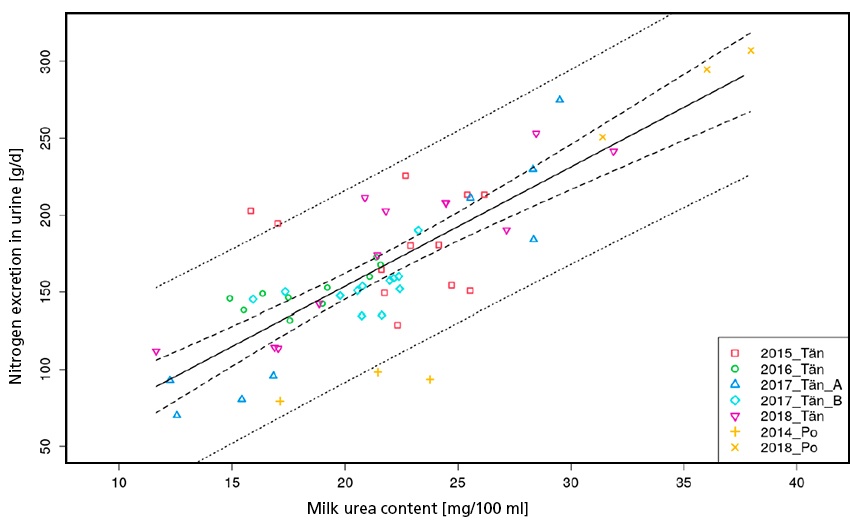Optimising Protein Feeding with the Help of Milk Urea Content
Photo: Agroscope, Gabriela Brändle
Excess nitrogen is excreted in the urine and leads to higher ammonia emissions. Nitrogen in the urine of dairy cows can be estimated based on the urea content of their milk. This information can be used to optimise protein feeding.
All options must be exhausted in dairy farming in order to achieve the environmental targets for ammonia. Here, feeding strategies start at the beginning of the nitrogen chain.
Main source of ammonia: nitrogen from urine
Oversupplying dairy cows with crude protein leads to increased excretion of nitrogen in urine. This must be avoided, since ammonia is formed mainly from nitrogen in the excreted urine.
Milk urea content is available from the monthly milk testing. In order to highlight the correlations between milk urea content and nitrogen excretion in the urine whilst taking into account the crude-protein content in the diet, experimental results from recent investigations were summarised and analysed in this study.
The greater the excess crude protein in the feed, the more nitrogen in the urine
Practical datasets from Agroscope from 2014 to 2018 from metabolic trials in Posieux and measurements in the experimental dairy housing for emission measurements in Tänikon formed the basis for these results. The range of the crude-protein content of the diets across all trials was wide. The analysis showed that the crude-protein content of the individual diets was reflected in the nitrogen excretions via urine.

Urea in milk as an indicator for nitrogen in urine
There was also a clear linear correlation between milk urea content and nitrogen in the urine. Since nitrogen excretion on commercial farms is not measurable and many farms do not analyse the crude-protein content of the diet on a regular basis, milk urea content can be used to classify nitrogen excretion. This information is available to dairy farms from the monthly milk tests at individual animal level or the periodic sampling of tank milk. Milk urea content determined in samples via both the enzymatic ‘reference method’ and the ‘mid-infrared spectroscopy’ (MIRS) method used for the official milk inspection showed a high level of agreement.
Conclusions
- Trial data from Agroscope show a good correlation between the crude-protein content of the diet and nitrogen excretion in urine.
- There is a clear correlation between milk urea content and nitrogen excretion in urine at herd level.
- As an available value from the monthly milk testing, milk urea content provides indications on nitrogen supply and excretion.
- Targeted inspection and adjustment of the feed can minimise ammonia losses, often even at the beginning of the nitrogen chain.
Bibliographical reference
Optimising Protein Feeding with the Help of Milk Urea Content



